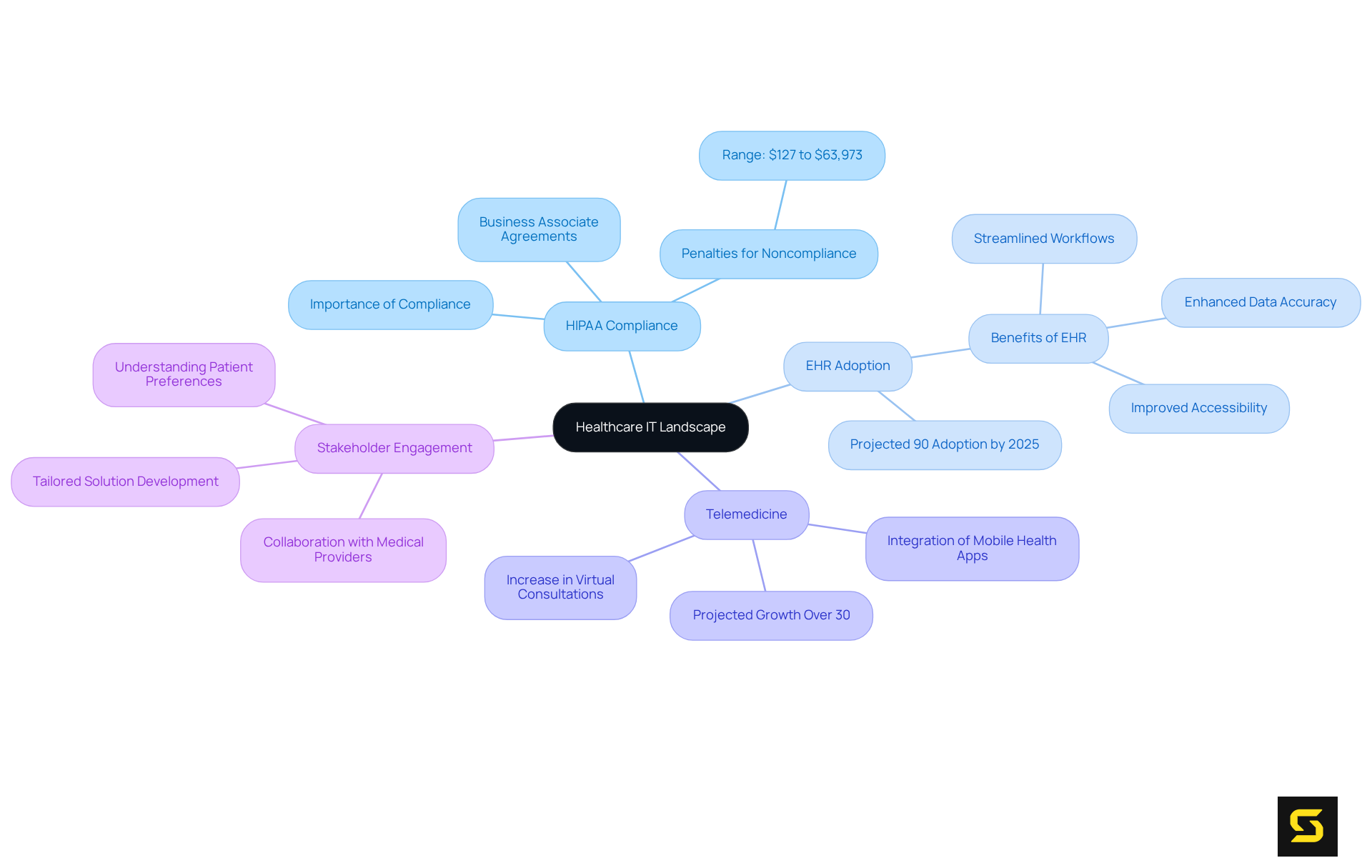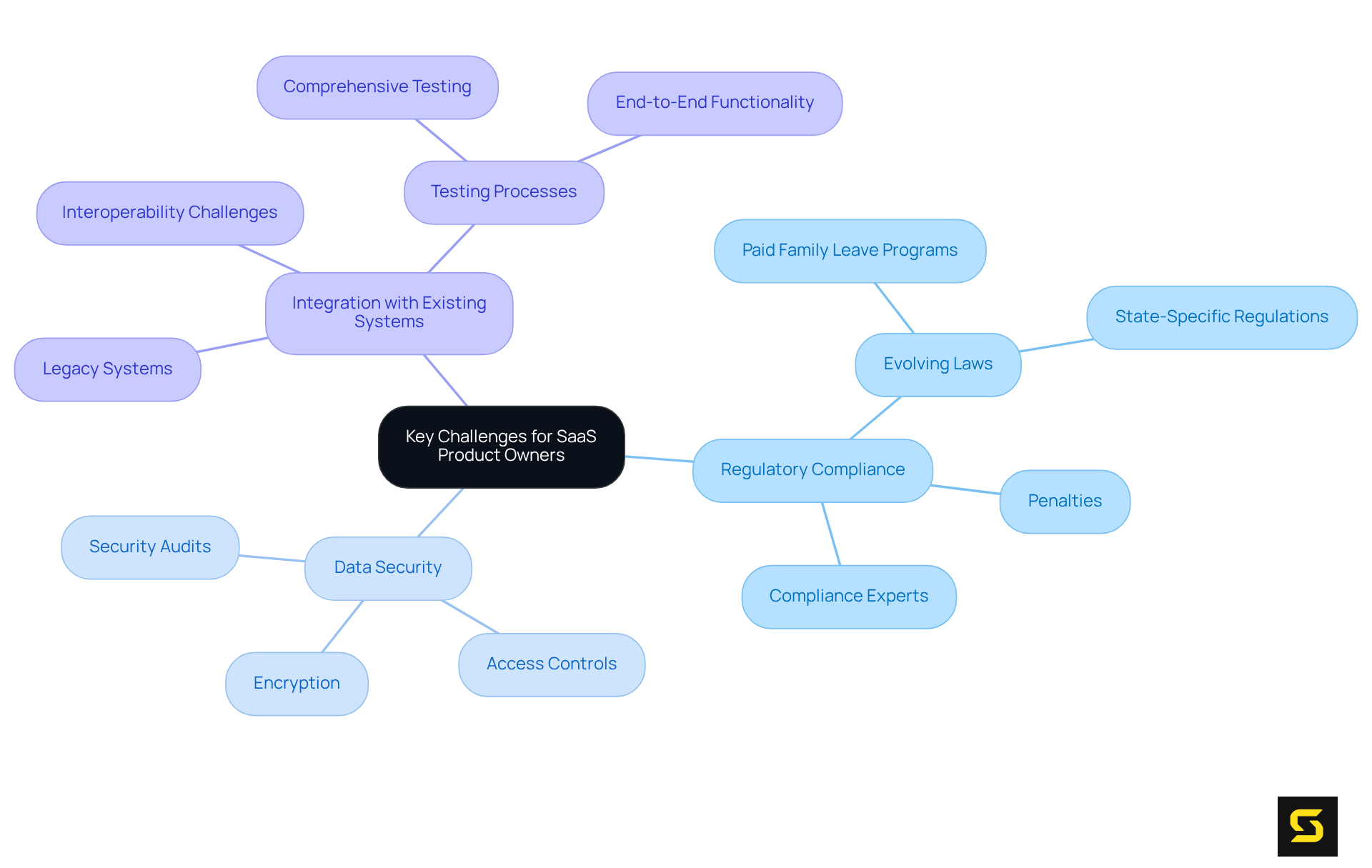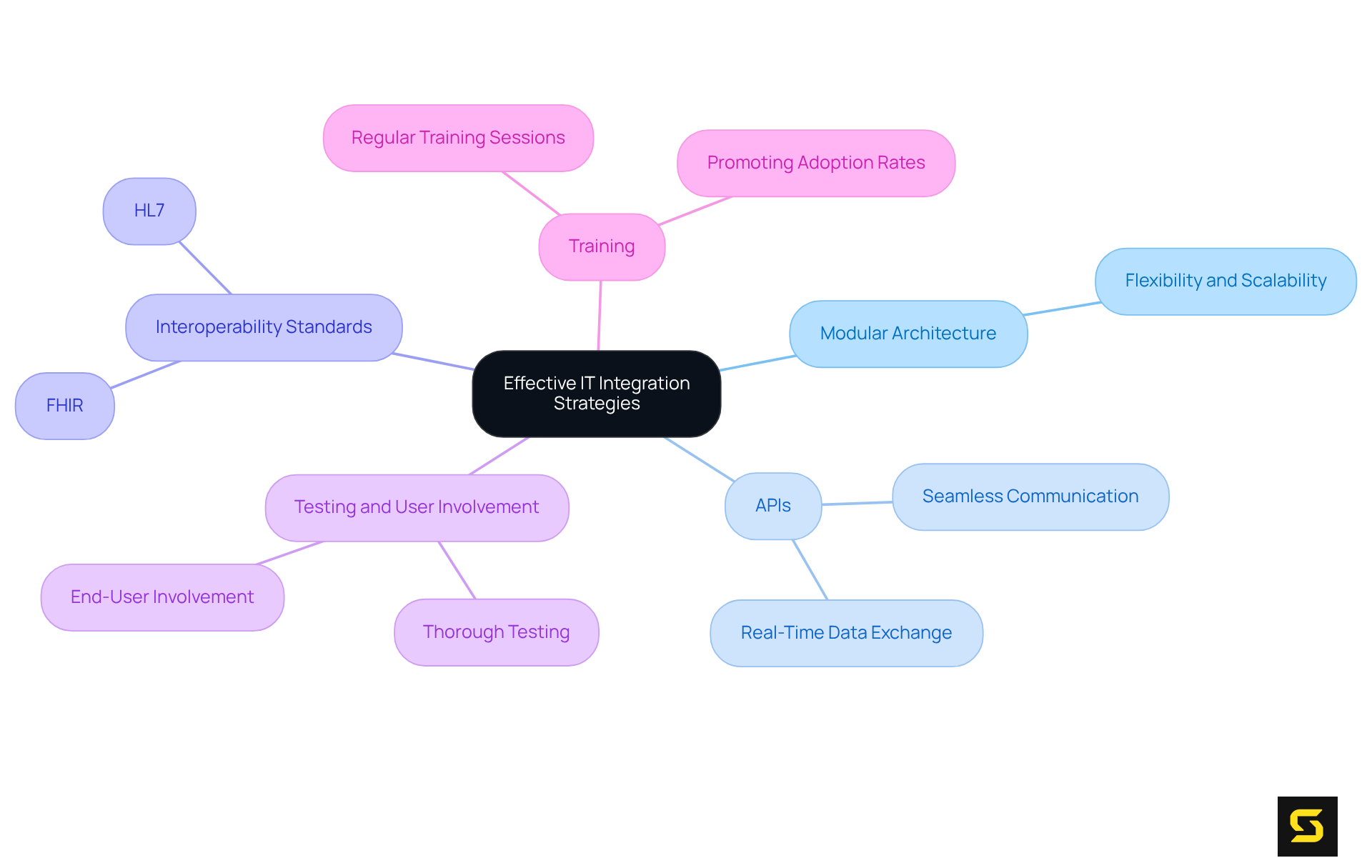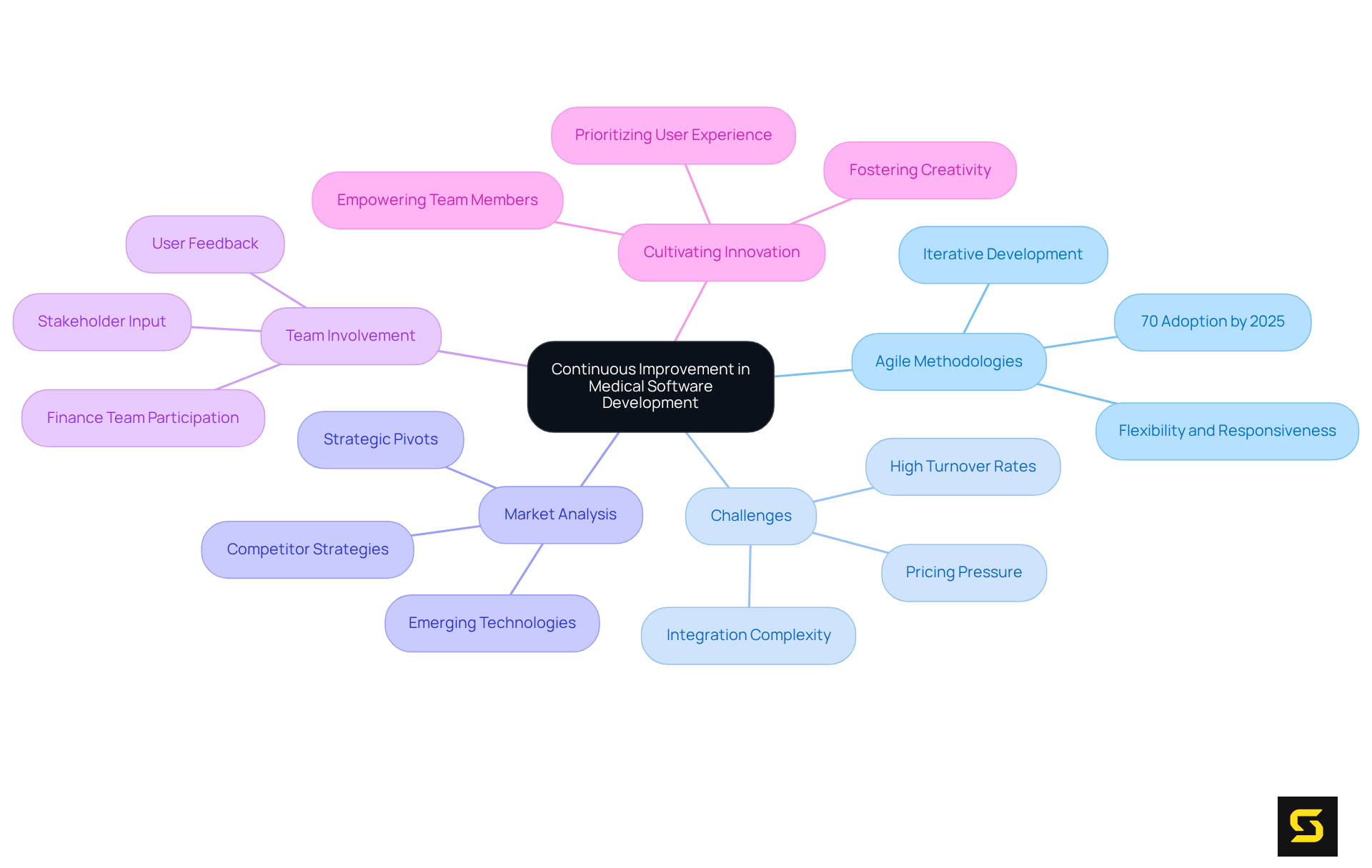Overview
This article presents essential strategies for achieving success in Software as a Service (SaaS) within the healthcare sector. It underscores the critical importance of:
- Regulatory compliance
- Data security
- Effective integration of IT systems
By detailing the significant challenges faced by SaaS product owners—such as navigating HIPAA regulations and ensuring interoperability—it advocates for the adoption of:
- Agile methodologies
- Continuous improvement
These approaches are vital for adapting to the rapidly evolving healthcare IT landscape. Embracing these strategies not only positions organizations for success but also reinforces their commitment to excellence in the healthcare domain.
Introduction
The healthcare IT landscape is undergoing a rapid transformation, propelled by technological advancements and an urgent demand for regulatory compliance. For SaaS product owners, grasping this dynamic environment is essential, as it opens doors to elevate patient care and boost operational efficiency through groundbreaking solutions such as Electronic Health Records and telemedicine.
Nevertheless, the intricacies of compliance, data security, and integration with existing systems present formidable challenges that necessitate strategic approaches.
How can SaaS providers adeptly navigate these changes while ensuring they fulfill the needs of both healthcare professionals and patients?
Understand Healthcare IT Landscape
The medical IT landscape is undergoing a profound transformation, fueled by rapid advancements in information technology in health care and evolving regulatory frameworks. For SaaS product owners, recognizing the critical importance of HIPAA compliance is essential, as it safeguards patient data and fosters trust within the medical ecosystem. By 2025, the adoption rates of Electronic Health Records (EHR) are projected to reach approximately 90%, underscoring the vital role of EHR systems in enhancing patient care and operational efficiency. Experts assert that successful EHR implementation not only streamlines workflows but also enhances data accuracy and accessibility, ultimately benefiting both providers and patients.
Telemedicine is reshaping medical service delivery, evidenced by a significant increase in virtual consultations and remote patient monitoring. This shift towards telehealth solutions is expected to expand by over 30% in the coming years, reflecting the growing demand for accessible medical services. As patient-centered care becomes the standard, integrating mobile health applications is crucial for addressing the evolving needs of patients.
Engaging with stakeholders, including medical providers and patients, is vital for gaining insights into their preferences and challenges. This collaborative approach can inform solution development, ensuring that offerings are tailored to meet genuine needs and enhance the overall experience in the field. Additionally, software as a service providers must remain vigilant regarding the specific penalties for HIPAA noncompliance, which can range from $127 to $63,973 per violation, alongside the necessity of business associate agreements to protect electronic protected health information (ePHI). By focusing on these critical elements, software service creators can navigate the complexities of information technology in health care and drive innovation effectively.

Identify Key Challenges for SaaS Product Owners
SaaS product owners in the medical sector encounter critical challenges related to information technology in health care that require immediate attention:
- Regulatory compliance
- Data security
- Integration with existing systems
Navigating the complex landscape of medical regulations is no small feat; non-compliance can result in severe penalties. As Brian Williams aptly noted, maintaining compliance amidst evolving laws can be intricate and perplexing, particularly with the introduction of new regulations such as paid family leave programs in states like Minnesota, Delaware, and Maine in 2025.
Furthermore, safeguarding sensitive patient information through robust data security measures is imperative in the context of information technology in health care to prevent breaches. Effective strategies must encompass:
- Encryption
- Access controls
- Regular security audits
Integration with legacy systems poses an additional hurdle, as numerous medical organizations still rely on outdated technology, complicating the adoption of innovative solutions and creating interoperability challenges in information technology in health care.
To address these issues, decision-makers should prioritize:
- Cultivating strong relationships with compliance experts
- Investing in secure, scalable architectures that enable seamless integration
- Implementing comprehensive testing processes that cover interoperability, compliance, regulatory, security, and safety testing
By prioritizing these strategies, software service providers can significantly enhance their offerings in information technology in health care, ensuring compliance while delivering secure and efficient solutions to medical organizations. This commitment not only fosters trust but also positions providers as leaders in the medical SaaS landscape.

Implement Effective IT Integration Strategies
To implement effective IT integration strategies, SaaS product owners must embrace a modular architecture that provides both flexibility and scalability. By utilizing APIs (Application Programming Interfaces), seamless communication between various systems can be achieved, enabling real-time data exchange. Furthermore, adopting standards such as HL7 and FHIR (Fast Healthcare Interoperability Resources) significantly enhances interoperability in information technology in health care across platforms.
- Thorough testing and active involvement of end-users in the integration process are crucial for identifying potential issues early on, thereby ensuring a smoother transition and heightened user satisfaction.
- Regular training sessions for medical personnel on new technologies are essential to promote better adoption rates, ultimately driving success in IT integration.

Embrace Continuous Improvement and Adaptation
Embracing continuous improvement is imperative in medical software development, where user feedback and stakeholder input play a pivotal role in identifying enhancement opportunities. The implementation of agile methodologies facilitates iterative development, enabling teams to respond swiftly to evolving requirements.
By 2025, statistics predict that 70% of healthcare IT projects will adopt agile practices, underscoring a significant shift towards flexibility and responsiveness within the industry. Nevertheless, software as a service providers face challenges such as high turnover rates and pricing pressure, critical factors that developers must consider when adopting agile methodologies.
Regular market analysis remains essential for staying informed about emerging technologies and competitor strategies, thereby allowing for timely strategic pivots. Furthermore, involving finance teams in software purchasing decisions is crucial to ensure cost-effectiveness and compliance.
Cultivating a culture of innovation empowers team members to contribute new ideas and solutions, fostering an environment where creativity can flourish. By prioritizing user experience and maintaining adaptability, SaaS product owners can ensure their products not only meet current demands but also anticipate future needs, effectively positioning themselves for sustained success in the dynamic healthcare landscape.

Conclusion
The transformation of information technology in health care presents both opportunities and challenges for SaaS product owners. Understanding the healthcare IT landscape—particularly the significance of compliance and integration—is crucial for delivering effective solutions that enhance patient care and operational efficiency. By focusing on these core elements, SaaS providers can position themselves to thrive in an ever-evolving environment.
Key insights from the article highlight the importance of:
- Navigating regulatory compliance
- Ensuring data security
- Embracing innovative integration strategies
The rise of telemedicine and mobile health applications underscores the necessity for SaaS product owners to engage with stakeholders actively and adapt their offerings to meet the changing demands of the healthcare sector. Moreover, continuous improvement through agile methodologies and user feedback is essential for staying competitive and responsive to market needs.
Ultimately, the significance of mastering information technology in health care cannot be overstated. By prioritizing compliance, security, and adaptability, SaaS product owners can not only overcome existing challenges but also drive innovation within the industry. Embracing these strategies will foster a culture of trust and collaboration, ultimately leading to improved patient outcomes and a more efficient healthcare system. Now is the time for stakeholders to act—ensuring that their solutions are not only relevant today but also future-proofed for the evolving healthcare landscape.
Frequently Asked Questions
What is driving the transformation of the healthcare IT landscape?
The transformation is being driven by rapid advancements in information technology in healthcare and evolving regulatory frameworks.
Why is HIPAA compliance important for SaaS product owners in healthcare?
HIPAA compliance is essential as it safeguards patient data and fosters trust within the medical ecosystem.
What is the projected adoption rate of Electronic Health Records (EHR) by 2025?
The adoption rates of Electronic Health Records (EHR) are projected to reach approximately 90% by 2025.
What are the benefits of successful EHR implementation?
Successful EHR implementation streamlines workflows, enhances data accuracy, and improves accessibility, benefiting both providers and patients.
How is telemedicine impacting medical service delivery?
Telemedicine is reshaping medical service delivery through a significant increase in virtual consultations and remote patient monitoring.
What is the expected growth of telehealth solutions in the coming years?
The demand for telehealth solutions is expected to expand by over 30% in the coming years.
Why is integrating mobile health applications important?
Integrating mobile health applications is crucial for addressing the evolving needs of patients as patient-centered care becomes the standard.
Why is engaging with stakeholders important in healthcare IT?
Engaging with stakeholders, including medical providers and patients, is vital for gaining insights into their preferences and challenges, which can inform solution development.
What are the penalties for HIPAA noncompliance?
The penalties for HIPAA noncompliance can range from $127 to $63,973 per violation.
What is the necessity of business associate agreements in healthcare IT?
Business associate agreements are necessary to protect electronic protected health information (ePHI).





